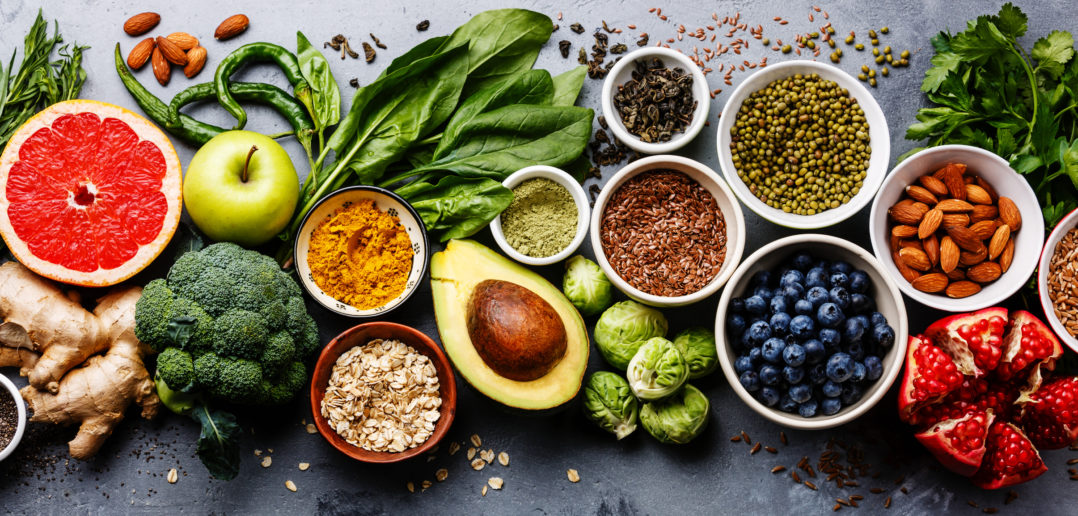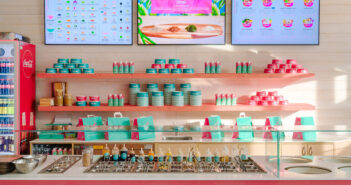The food and beverage (F&B) sector has arguably been the most innovative market within retail and leisure over the past decade and yet operators also face extraordinary challenges, as consumer demands evolve quickly and dramatically. After all, who could have foreseen the soaring demand for vegan food in the US and UK, or the rise in corporate backing for plant-based foods, with the likes of Bill Gates and We Work co-founder Miguel McKelvey as high-profile protagonists.
Similarly, food allergens and ethical and environmental awareness are rising at the same time as consumers show an increasing willingness to embrace new world foods, fusion offers and even consider insects as a new lean protein source.
We asked four industry experts for their views on how food operators can embrace these diverse requirements and lead the agenda.
James Hacon, partner and managing director, Think Hospitality

Source: Foxys_forest_manufacture
Q. There are so many nutritional, dietary and ethical food trends… what advice would you give F&B operators about how they shape and adapt their offers?
JH. You have to differentiate between a trend and an allergen; as an operator you have a legal obligation to clearly communicate any allergen information for your customers. In the past year there have been far too many well-publicised serious incidents with people becoming very ill or even losing their lives due to labelling or processes. As companies selling food, our first responsibility, ahead of anything else, is the safety of our customers.
There has been a trickle of brands that have come through recently and announced that they are sticking to their recipes with absolute conviction, to ensure the analysis around allergens is accurate, as allowing for changes and swap-outs can cause unexpected consequences, which in turn puts a lot of responsibility on often junior frontline staff.

Mixed use retail and leisure: What happens next? – White Paper
When it comes to food trends, it’s important to distinguish between the secular trends that are for the long term and cyclical trends that come and go. As an operator, you may want to adapt your seasonal or special ranges with the cyclical trends, but your core ranging should only really be influenced by secular trends. An example of this is the secular trend towards plant-based foods, primarily influenced by the impact of meat production on the environment.
A good example of cyclical food trend is the latest popular global flavour – for now it’s South American and Hawaiian, for instance.
Q. What are the best strategies for food players to meet consumer expectations? Is it better to respond, to lead, to create the agenda? How do you work out what is a trend and what is a fad?
JH. Within your brand you need to understand your consumers; are they disruptor trendsetters, looking for the latest and greatest new thing? Or perhaps a more mainstream audience, who like what they like and might venture to try something new once in a while. There are very few brands that truly create the agenda or even lead – there is a clear flow in the foodservice sector from high-end chefs and restaurants pushing the boundaries, to more dynamic brands quickly taking advantage, then the majority watching others try and fail, before going out with a proven concept.
A great example is pulled pork. It took five or six years for it to go from being the latest thing in Michelin kitchens to a staple on fast food menus and subsequently every supermarket shelf.
There are some tell-tale signs:
- Trends evolve – they are not revolutionary. We crave familiarity, it’s human nature. If you see a ‘food trend’ that seems to come from nowhere it’s likely to have a limited shelf life. If it’s evolved out of something else, that we know and understand, it’s far more likely to be here for the long term.
- Know where to get inspired – we know that many of the future foods come from Michelin kitchens, but even within high-end kitchens there’s a hierarchy as such, with some chefs defining themselves as pushing the boundaries, while others are more conservative. The conservative ones will still be well ahead of the high street, but will be filtering what customers will accept and handle far more than the ‘out-there’ chefs. These are the ones to visit and get inspired by.
- Consider hidden agendas – if you’d have been to any major food conference for the past few years you’d be told that edible bugs are the new trend. You’d have been told by people farming those said bugs, obviously. While I have no doubt this is our future, I’m not sure it’s going to appear on the majority of plates anytime soon, instead it’s likely to make it into our diet through manufacturer products. The point here is that manufacturers and suppliers have an agenda. Be aware of this and that many articles we read in the trade press are sponsored and could be influenced.
- Use common sense – think about things as a consumer, test things with your actual customers, put in internal checks and balances with multiple people having a view in your organisation. Use external research agencies to look at what’s happening out there in the market and challenge you too. Most of all, use some common sense.
Q. How would you advise operators to source upcoming trends and develop new businesses, especially as the market becomes increasingly competitive?
JH. Work with great agencies and consultants who can take you out of your comfort zone and your own backyard, inspiring you from further afield. Go on study tours, travel, there is no better inspiration. Analyse competitors, but through a lens of your own strategy. Ask your customers what they want and test with them as part of your development process. Listen to them and you will learn.
Manuela Borella, manifesto innovation accelerator general manager, Danone.
Q. There are so many nutritional, dietary and ethical food trends… what advice would you give F&B operators about how they shape and adapt their offers?
MB. The first thing is to say is that we have to understand how the human being has changed. And I use this phrase, rather than consumer, very carefully. Now everyone has lots of information available to them, not just the few, and information is power.
Of course this is positive and negative, because we have fake news. But information is shaping people and impacts on consumption because people know much more than they used to and in turn they are much more demanding. And within food and beverage it is important that we are part of solutions, not part of the problem.
Q. What are the best strategies for food players to meet consumer expectations? Is it better to respond, to lead, to create the agenda? How do you work out what is a trend and what is a fad?
MB. So if we know that there are global trends on everything from the environment to nutrition to labelling, then we have to know how to adapt to this. The first thing I would stress is the need to connect to the trends locally because global trends are not always adopted in each country the same way. For example, veganism is very big in the UK, but not so much Western Europe. In France, organic is very important to consumers.
Will vegan be big in France? We don’t know yet. So we have to look at and analyse what we feel the trends of tomorrow will be, which is where data comes in, because it gives us a clear idea of how the market is moving.
Once we have this data, my advice is that you should follow your gut. Whatever the trend, you must work out how it matches the values of your company and ensure that improvements to the product are aligned with this. For example, at Danone we aspire to constantly improve the healthful nature of our products and the nutrition, so any changes have to be consistent with this.
Consumers are very sensitive to when an adaptation is made with integrity or when it’s just a marketing ploy.

Mixed use retail and leisure: What happens next? – White Paper
Q. How would you advise operators to source upcoming trends and develop new businesses, especially as the market becomes increasingly competitive?
MB. First you have to identify where your company values fit with the trend and whether you should react or lead. Increasingly this also demands collaboration, because in something like packaging for example, Danone cannot do it on its own. So we have to co-operate with our businesses to make a change together.
In other areas, where perhaps governments used to take a lead, you can be more radical and drive the agenda.
My advice is first to start with the customer and see what they are doing and what they value, then use market data to understand where you have a competitive advantage. Finally, you should talk to experts who have the analysis or the roles to understand the trend. You need to bring all three of these data points together in order to innovate.
We work with start-ups to introduce and test things very quickly, which allows us to accelerate processes and to decide rapidly whether to take a project forward.
Q. How do you ensure that a large company like Danone can adapt and respond to change quickly?
MB. While trends do travel globally, and quickly, their expression is different in different markets. So, for example, organic may be important in the US and Europe but that is not expressed in China. So you need to look at the trend, then stop and think about how it passes through the ‘local gate’ before you act.
But of course things happen faster and faster and for us, once we have made a decision to progress, we have a portfolio of established partners who help us move very quickly. This means we can accelerate each part of the process and evaluate the KPIs.
Marco Beolchi, retail food specialist

Source: fortyforks
Q. There are so many nutritional, dietary and ethical food trends…what advice would you give F&B operators about how they shape and adapt their offers?
MB: I think today the challenge is not only to be able to adapt one’s offer of products and services to the current trends, creating vegan, Asian or exotic flavour concepts, but also to “be relevant” to people. In order to do this, social media is increasingly crucial, now that even longer content is becoming increasingly familiar. This represents an opportunity for brands to bring value by providing relevant content in a transparent, spontaneous and non-intrusive way. Furthermore, social commerce today represents only a small percentage of total retail sales, but this number is expected to explode in the coming years and therefore the added value will be to integrate social commerce in traditional sales networks, building a true omni-channel digital and social marketing strategy.
Q. What are the best strategies for food players to meet consumer expectations? Is it better to respond, to lead, to create the agenda? How do you work out what is a trend and what is a fad?
MB. I believe all trends are subject to a life cycle; we are talking more and more about sugar-free products, culinary cannabis, Burmese or Filipino cuisine, mocktails, gut-healthy food, fermented foods, or particular ingredients such as turmeric and gomasio, or robotic kitchens and waiters, and much more, but you can’t change the menu every day. It is useful to keep an eye on the change in taste and new trends to intercept customers’ tastes but it is crucial to stay true to yourself bearing in mind that what makes a format unique is its history and its community.
Q. How would you advise operators to source upcoming trends and develop new businesses, especially as the market becomes increasingly competitive?
MB. The F&B operators are and will be more and more committed to regaining the trust of their customers, this is the focus in a highly competitive market, certainly not integrating the menu with products based on marijuana or insects. They will have to provide certainties about company products and policies, as well as absolute transparency of information, giving visibility also to inconvenient details. In the era of fake news, the lack of confidence in brands has multiplied. It is no longer enough to publicise one’s honesty, social charity or environmental commitment: others must prove it.
The formats will have to be increasingly guided by ideas and interactions with consumers, turning them into contributors. Those who follow a brand need to feel a sense of real belonging to the brand community and to perceive that they are playing an active role that generates new ideas and products, based on real-time feedback from buyers. This is how the community will become not only a customer but also the biggest asset of the brand.
Monica Cannalire, national director – head of retail agency, JLL Italy
Q. There are so many nutritional, dietary and ethical food trends…what advice would you give F&B operators about how they shape and adapt their offers?
MC. There are two opportunities for F&B operators – the first is to launch a start-up, the second to update and upgrade what you have. Unfortunately, F&B is seen as something of an Eldorado by many new players who approach the industry in a spontaneous, improvised way which is often very short-lived and far from the reality.
It can be hard for established businesses but I would say the first thing to do is to start simply – the menu is a great place to begin. For example, look at alternative proteins like tofu so that you can offer a dish in an alternative form as vegetarian or vegan. Or look at lighter version of your dishes. Then ensure the staff are very well informed about ingredients and allergies. This provides great customer service, yet it is not the reality of many restaurants, which can be very stuck in their ways. This in turn involves upgrading your employees, by training them.
Another way to add value is through food standards. We have moved on from zero kilometre food to understanding the path of the food and how it was taken care of. So pick products carefully.
Finally, many F&B operators don’t know how to tell their story. They need to understand how to talk about who they are and what they stand for. Changing trends are not a dark cloud, they are an opportunity.
Q. How would you advise operators to source upcoming trends and develop new businesses, especially as the market becomes increasingly competitive?
MC. The reality is, you need help. You need assistance from people who work with new media to share information about you. You need to enlist help from real estate professionals, who have experience is seeing what works and what isn’t working. So ask for advice from the right people and be humble enough to listen. Let someone else be a mirror for you in what you are doing.
Q. And for those starting out or expanding, how do you choose your format and your location?
MC. Be wise and optimise your space. Also, don’t get stuck in where you came from, be flexible. It’s like trying to remix an existing song – it doesn’t have to be the same but it should have the same basis. We often work with successful suburban operators who want to bring their format into the city centre. They are probably used to a large restaurant with a big kitchen for a reasonable rent. In the city the space is going to be more limited and more expensive, so it’s about adaptation and optimisation.
So my advice is to be flexible and also to keep your first set of stores geographically close to the original, so that you can keep an eye on them all. This means you can ensure that they are still telling the right story and that the standards are consistent with your values. It also means that you should choose very carefully about when you franchise, because while you may have the kit and the equipment, you have to ensure that you can support the franchise partner to tell your story, otherwise your brand will lose consistency.
You also need to understand your location, so for example an express format needs to be in a high footfall location, giving you the visibility you need, while a destination restaurant will draw customers. But above all, running an F&B operation requires stomach, passion and a love for what you do.
Don’t miss MAPIC Food!



![[NEW] MAPIC interview: In conversation with Tobias Karlsson, Global Real Estate Director, KIKO Milano](https://www.beyondretailindustry.com/wp-content/uploads/2024/05/MicrosoftTeams-image-44-5-351x185.jpg)
![[NEW] MAPIC interview: In conversation with Giovanni Porcu, CEO and founder of Doppio Malto](https://www.beyondretailindustry.com/wp-content/uploads/2024/03/DM-Magenta_1-351x185.jpeg)